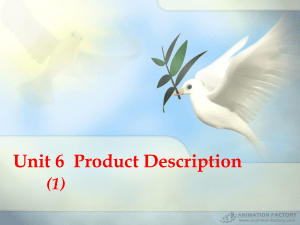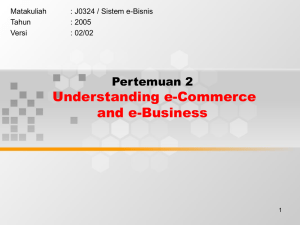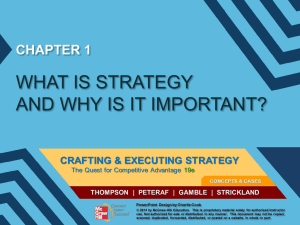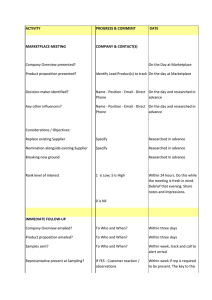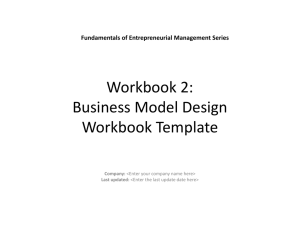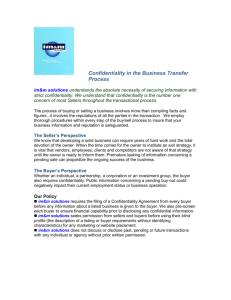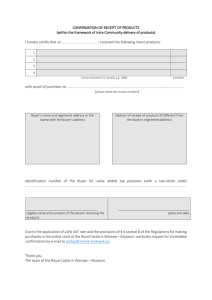Frameworks and Business Models
advertisement
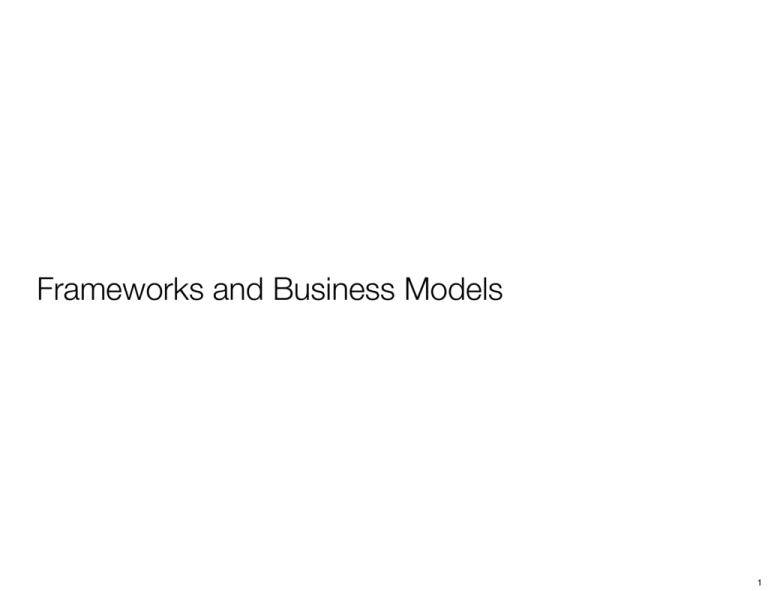
Frameworks and Business Models 1 Remark - Technology Changes Business • Technology changes how business is done • Example: travel agencies • travel agencies must reinvent themselves • stock exchange, real estate, e-learning 2 Customers service • Example: zappos.com • Business service based on customer service and customer loyalty 3 Zappos.com Customer Loyatly is important... 4 Cut & Improve • Unusual feature of e-commerce: • offers opportunities to cut costs *and* offer better services at the same time • Example: UPS package tracking • before e-commerce: phone call to track the package • limited in time, needs personal • now: automatic web-based tracking • 24/7, faster 5 A Framework for EC • A framework or conceptual schema or conceptual data model is a map of concepts and their relationships. This describes the semantics of an organization and represents a series of assertions about its nature. Specifically, it describes the things of significance to an organization (entity classes), about which it is inclined to collect information, and characteristics of (attributes) and associations between pairs of those things of significance (relationships). 6 A Framework for EC Exhibit 1.2 7 Columns • Pepole: sellers, buyers, intermediaris, information systems specialists, and any other participants • Public Policy: legal aspects, taxes, privacy enforcement, technical standards, etc. • Marketing and Advertisement: important in B2C where buyer and seller do not know each other • Support services: online payment systems, content management systems, etc. • Business Partnerships: the interactions between a company and its supplyers 8 A Framework for EC Exhibit 1.2 9 Case of Study: Godiva.com 10 Something unique • You have to offer something unique that have value for customers... • ... and make money at the same time • You can’t be unique by losing money or breaking laws • How can i be unique, create value, and make money? • The answer to this question, is what we call a business model • A comprany is successfull as his business model is successful 11 6 • 6 Dimensions of an e-commerce business model • Who are our customers, who are we selling to. Gender, socio-economic divisions, etc. • What products and services are we going to offer. • Business processes. How we make and deliver the products, how we conduct operations. • Resources. Finding products that nobody else sells, of find better prices. • Supply chain. Who are our suppliers, how we acquire goods. • Finances. How are we going to manage costs and make money. 12 Business Model Elements • According to [McKay and Marshall 2004] a business model is composed by 6 elements: • A description of the customers and the company’s relationships with customers • a description of all products and services the company offers • a description of the business process • a list of resources required and available • a description of the supply chain, including suppliers and business partners • a description of the revenues expected (revenue model), costs, etc. 13 Other definitions of Business Models • One of the main characteristics of EC is to enable new business models. New ways of making money. • Business model: a method of doing business by which a company can generate revenue to sustain itself • [Weill and Vitale 2001] developed a framework for evaluating the validity of e-business initiatives • eight atomic business models that can be combined to form more complex business models 14 Atomic Business Models • Direct Marketing • Intermediary • Content Provider • Full-service provider • Shared infrastructure • Value net integrator • Virtual community Example: Amazon.com combine direct marketing, intermediary, virtual community and content provider • Consolidator of services 15 Value Proposition • Business models also include a value proposition: • Value proposition: The benefits (tangible and intangible) a company can derive from using the model 16 Revenue Model • Revenue model: description of how the company or an EC project will earn revenue • Sales: selling merchandise or services • Transaction fees: commissions on the volume of transactions made (per value or per transaction) • Subscription fees: fixed amount (usually monthly) to get some type of service • Advertising fees: charging for placing advertise • Affiliate fees: commissions for referring other’s websites • Other revenue sources: pay-for-play, pay-for-watch, licensing, etc. 17 Common Revenue Models Exhibit 1.6 18 Typical Business Models • Online direct marketing: selling products or services online • Electronic tendering system: (reverse auction): model in which a buyer requests would-be sellers to submit bids, and the lowest bidder wins • Name your own price: a model in which a buyer sets the price he or she is willing to pay and invites sellers to supply the good or service at that price • Find the best price: also known as a search engine model • Affiliate marketing: an arrangement whereby a marketing partner (a business, an organization, or even an individual) refers consumers to the selling company’s Web site • Viral marketing: word-of-mouth marketing in which customers promote a product or service to friends or other people • Group purchasing: quantity purchasing that enables groups of purchasers to obtain a discount price on the products purchased 19 Typical Business Models - II • Online auctions: different types of auctions, usually a sequence of consecutive bids for various goods and services, the highest bid get the auctioned item • Product and service customization: creating or modifying items following the buyer’s specifications • Others: marketplace exchanges, information brokers, bartering, deep discounting, membership, value-chain integrators, value-chain service providers, supply-chain improvers. 20 Dynamic Business Models • In order to succeed in the fast moving marketplace, business and revenue model must change • Amazon went from books to everything, added marketplace, etc. • AOL: 20 Years of AOL Annoyances and Foul-Ups - PCWorld 21 Summary • Definition of EC and description of various categories • The content and framework of EC • The major types of EC and business models • Case of studies • Overview of benefits and limitations 22

